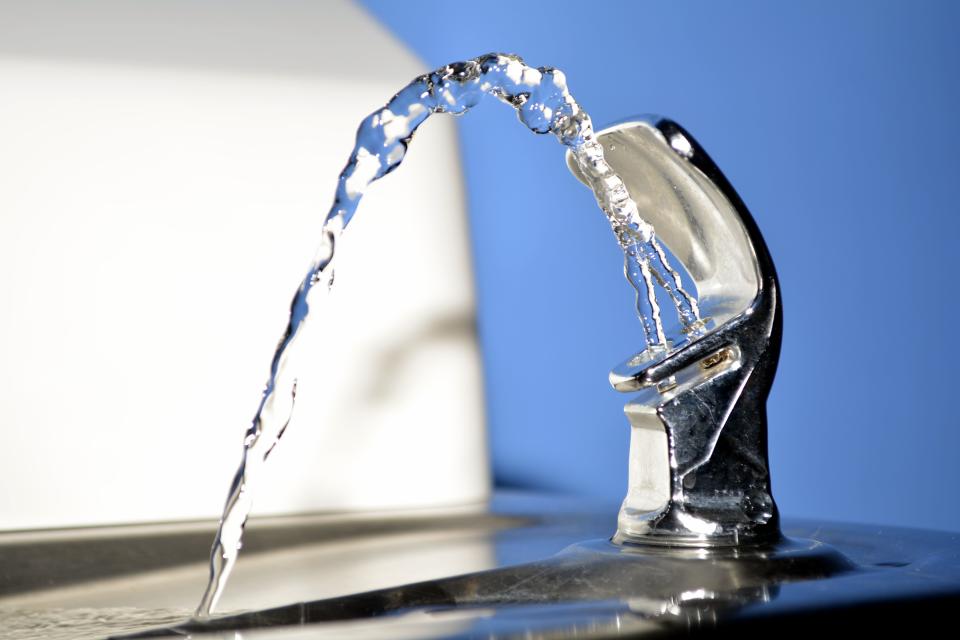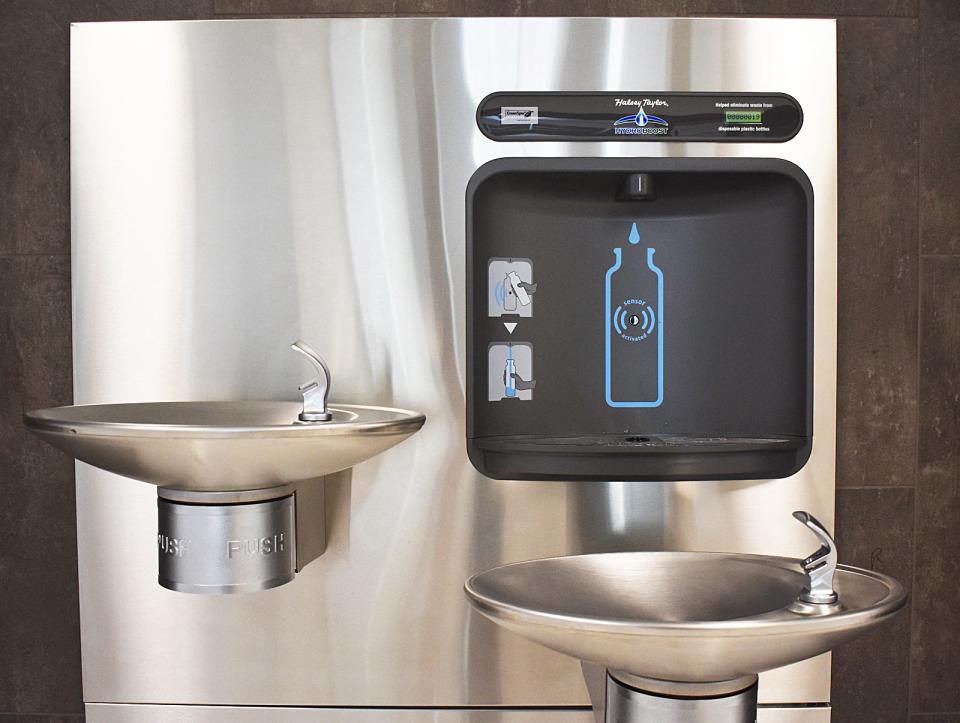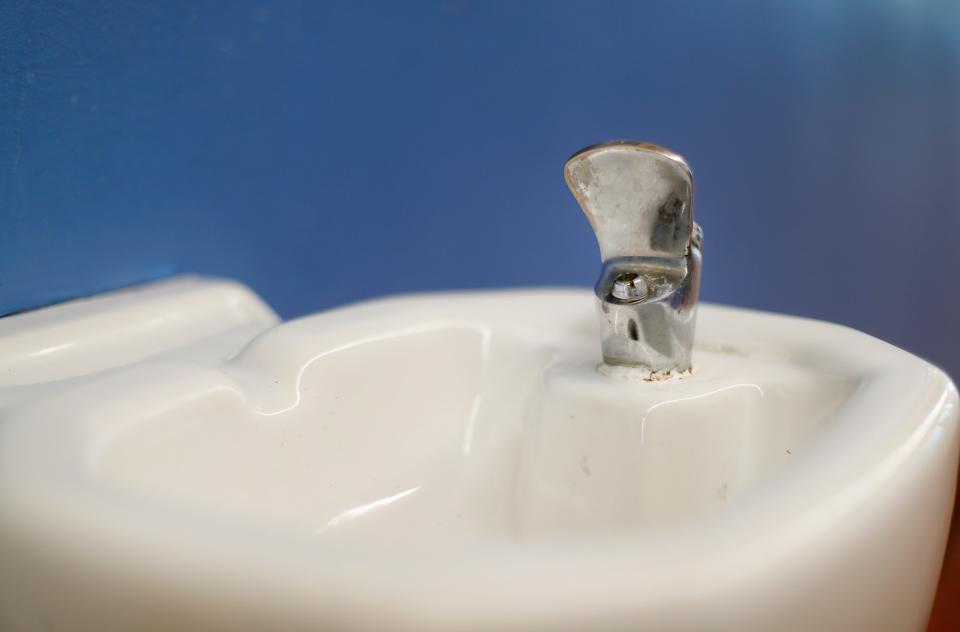Do Springfield schools have safe drinking water? Here's what lead testing results show
The Springfield school district has finished testing lead levels in all its classroom sinks, hallway fountains and other water lines that may be used for drinking, food preparation or cafeteria cleanup.
Results from 27 buildings — roughly half of the sites — have been returned and posted publicly.
Travis Shaw, deputy superintendent of operations, said testing for all district buildings was done by late December.
"We have received half of the test results back," Shaw said. "But we have tested every building."
Samples from 25 of the buildings showed one or more water sources had a lead concentration level above the state standard, which is "five parts per billion" or ppb.

The state set its standard lower than the minimum level set by the U.S. Environmental Protection Agency, which is 15 ppb. In the first group of results, 21 buildings also had one or more water sources that exceeded the higher EPA level.
Under a new state law, districts must develop a plan to test all school water sources for lead by Jan. 1 and complete testing by August 2024.
The "Get the Lead Out of School Drinking Water Act," approved by lawmakers in 2022, also requires schools to take corrective action if tests show a water sample exceeds the limit set by the state.
Lead exposure in children may cause adverse health effects on brain and neurological development, behavioral problems, reproductive and renal complications and impaired growth.
The January results showed just two Springfield schools — Fremont Elementary and York Elementary — with no samples higher than the state or EPA levels. Fremont was renovated and partially rebuilt in 2016 and a rebuilt York was opened in 2023.
Four schools only had one water line out of compliance and the rest were in line. They included Boyd and Williams, rebuilt schools that opened in 2023; McGregor Elementary; and the Arthur Mallory Early Childhood Center, which is a fully renovated former grocery store.

At three schools, half or more of the water sources tested found lead amounts above the recommended levels:
Pleasant View, a K-8 campus: Of 48 sources tested, 32 were above state level and 22 were also above EPA level;
Truman Elementary: Of 67 sources tested, 34 were above state level and four were also above EPA level;
Phelps Center for Gifted Education: Of 31 sources tested, 16 were above state level and six were also above EPA level.
Taking steps to lower lead levels
Under the state law, public schools are required to test any water outlet that is used, or may be used, for drinking, food preparation, cooking or cleaning kitchen utensils. The sources can include water fountains or coolers, bottle fillers, ice machines, faucets, hydrants, spigots or taps.
To accomplish that, the district contracted with independent firm Axiom Service Professionals to collect and test samples. For just the 27 buildings with results, that meant examining nearly 1,000 samples.
"We felt we needed to put this out to bid and have a third party do the work. Many districts have taken the same approach," Shaw said.
"It took about a month and a half to complete all of the testing. As you can imagine, in certain buildings there were over 100 tests that needed to be done, in high schools for example. That part has been pretty seamless."

Shaw said the initial results, for the 27 buildings, came in quicker than expected. Once received, they are posted on the district's website, as required.
"We have no way of knowing how quickly we will get everything else," he said.
The Springfield district budgeted $500,000 for testing and remediation before learning the state planned to allocate another $500,000.
"We were pretty aggressive when it came to testing," Shaw said. "If we had any doubt that we should (test), we did."
By late January, the district had spent $246,799 as part of the contract. The district estimates it will spend $50,000 in the original round of filters but that may change once the rest of the results are in.
Districts must take steps to lower lead concentration levels in any source over the state limit. Here are the expected steps, depending on the situation:
Water source will be turned off or signage will be posted saying not to drink the water until corrective actions are taken;
Filters will be installed on water sources used primarily for drinking or cooking and, in some cases, pipes and fixtures will be replaced;
Signs saying "not for drinking or cooking" will be posted on certain water sources such as classroom sinks;
Follow-up testing will be conducted to make sure the steps taken reduce the lead concentration levels.
As test results come in, Shaw said the priority is to addressing any source primarily used for drinking water with a result higher than the state limit.
"If it is a water fountain, those are turned off and our (facilities) team begins working on installing filters in order to remediate that," Shaw said. "In the event that we have five out of five water fountains that are turned off, then it is our (plan) to provide bottled water to that particular school until we have this addressed."
Shaw said, as of mid-January, the district has not had to provide bottled water to any school. The state deadline to get the remediation done is Aug. 1 but Shaw the district is moving as quickly as possible.
Why lead exposure matters, especially in children
Lead exposure is a statewide issue, with the average blood lead level of children in Missouri far above the national average at 8.8 micrograms of lead per deciliter of blood at the 97th percentile, according to the Department of Health and Senior Services.
Three-and-a-half micrograms of lead per deciliter of blood is what the Centers for Disease Control and Prevention considers higher than most children in the nation. To put that in perspective, 3.5 micrograms in a deciliter is equal to 1/16 of a grain of salt in about half a cup of water.
Experts say there is no safe level of lead in a child's blood.
Low levels of lead can cause behavior and learning problems, lower IQ, hearing problems, slowed growth and anemia, according to DHSS. High levels put children at risk for seizures, coma, permanent brain damage and even death.

“Once the damage is done, the damage is very difficult to address,” said Dr. David Barbe, a family medicine physician with Mercy. “The big deal with lead is prevention: We do have ways to lower the lead levels in the bloodstream but depending on how long it’s gone on and how much damage it’s already produced, the damage is what we don’t have a good handle on reversing.”
Dr. Kofi Asare-Bawuah, medical director for children’s services at CoxHealth, said it can be difficult to tell when children are exposed to lead. Symptoms can range from increased hyperactivity, memory issues and increased irritability to abdominal pain, seizures and altered mental status.
A sign that something may be off is pica, a condition where a child eats something that is not food, like paper, clay, soil or ice. Pica can indicate nutritional deficiencies such as anemia.
“Lead has toxic effect on the bone marrow that makes blood cells, and that results in anemia. We typically do follow anemia testing in children also, so that is occasionally the first clue, can be the first clue of lead levels,” Barbe said. “If a kid is anemic and there isn’t a good explanation for that or as part of the evaluation, (checking their) lead level is possibly in order.”
Parents concerned that their child may have been exposed to lead should consult their pediatrician, said Whitney Mann, spokesperson for the Springfield-Greene County Health Department. A pediatrician can determine if a child's blood level should be tested.

If a child age 6 and younger is diagnosed with lead poisoning, the health department will investigate to identify the source of lead exposure and how to remediate it.
Children younger than 6 are most susceptible to lead poisoning because their bodies are rapidly developing. Kids in that age group are also more likely to stick things in their mouths.
The results for three of Springfield's early childhood centers — Campbell, Mallory and Shady Dell — were released in January.
An individual previously exposed to lead in their life can pass that exposure down to their child, in a way. To the human body, lead looks a lot like calcium, and is stored in the bones the way calcium is, according to Harvard’s Science in the News group. During pregnancy, the body releases calcium — and therefore, its lead lookalike — to help form the fetus’s bones.
Lead in the blood during pregnancy can increase the risk for miscarriage; cause premature birth; hurt the fetus’s brain, kidneys or nervous system; or cause the child to later have learning or behavior problems, according to DHSS.
In adults, lead exposure can cause high blood pressure, joint and muscle pain, headache, abdominal pain, mood disorders, difficulty with memory or concentration, and reduced sperm count or abnormal sperm, according to the Mayo Clinic.
SPS results for 27 buildings, including 22 schools:
Bissett − Of 27 water sources tested, 11 exceeded state level, four were also above EPA level;
Bowerman − Of 23 water sources tested, seven exceeded state level, two were also above EPA level;
Boyd − Of 48 water sources tested, one exceeded state level;
Campbell − Of 20 water sources tested, eight exceeded state level, two were also above EPA level;
Fremont − Of 48 water sources tested, none exceeded state level;
Hillcrest − Of 152 water sources tested, 63 exceeded state level, 13 were also above EPA level;
Mallory − Of 29 water sources tested, one exceeded state and EPA level;
McGregor − Of 39 water sources tested, one exceeded state and EPA level;
Phelps − Of 31 water sources tested, 16 exceeded state level, six were also above EPA level;
Pleasant View − Of 48 water sources tested, 32 exceeded state level, 22 were also above EPA level;
Reed, temporary location − Of 32 water sources tested, 10 exceeded state level, six were also above EPA level;
Robberson − Of 25 water sources tested, six exceeded state level;
Rountree − Of 18 water sources tested, two exceeded state level;
Shady Dell − Of 13 water sources tested, three exceeded state level, one also exceeded EPA level;
Study − Of 67 water sources tested, 31 exceeded state level, 13 also exceed EPA level;
Truman − Of 67 water sources tested, 35 exceeded state level, four also exceeded EPA level;
Watkins − Of 32 water sources tested, 10 exceeded state level, one also exceeded EPA level;
Weaver − Of 40 water sources tested, 18 exceeded state level, nine also exceeded EPA level;
Weller − Of 54 water sources tested, 24 exceeded state level, five also exceeded EPA level;
Westport − Of the 90 water sources tested, 30 exceeded state level, 12 also exceeded EPA level;
Williams − Of the 42 water sources tested; one exceeded state and EPA level;
York − Of 32 water sources tested; none exceeded state level.
Results for other buildings:
General Service Center − Of 19 water sources tested, six exceeded state level, two were also above EPA level;
Kraft Administrative Center − Of 10 water sources tested, one exceeded state and EPA level;
Launch Virtual Learning Center − Of nine water sources tested, one exceeded state and EPA level;
School police and Foundation for Springfield Public Schools − Of two water sources tested, one exceeded state and EPA level;
Transportation Center − Of eight water sources tested, two exceeded state level.
This article originally appeared on Springfield News-Leader: Here's what lead testing found in Springfield public schools' water

